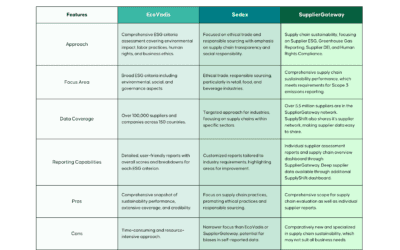
Originally written by Kayleigh Shooter for SupplyChainDigital
COP26 has highlighted the importance of sustainability, read the ten ways that you can operate a sustainable supply chain, with reference to ShipERP’s blog.
What is the meaning of sustainability? Sustainability has been at the forefront of people’s minds for years, but COP26 and similar events have highlighted the real need for change and for sustainability, sustainability is (simply) meeting our own needs without compromising the ability of future generations to meet their own needs.
We share ten tips for supply chain professionals to bear in mind.
1. Use recyclable materials
Many companies use plastic, which is not biodegradable, it is important that companies consider alternative, recyclable materials such as cardboard, paper, or bubble wrap as these are all biodegradable and are versatile, therefore they can be used for most, if not all, types of products.
2. Use alternative packaging materials
Many businesses are already exploring the avenues of plant-based products, so why not explore plant-based packaging? Instead of using packaging peanuts made from Styrofoam, consider using air pillows that are made from recyclable materials, not only are these cheaper to purchase and ship, but they are better for the environment as they can be recycled and used again.
3. Minimize production and supply chain processes
Your suppliers and manufacturing partners are there to support you, work in partnership with them to reduce the environmental impact of your supply chain. Many suppliers and companies alike can cut down or even eliminate their use of paper by going mobile in certain stages of the process.
4. Avoid pictures and text on packaging
Customizing your packaging can add a special touch for the consumer, but at what cost? Customizing your packaging can take up more resources and use up more materials. Instead of using expensive printing ink or similar, consider options such as inks that are made from milk proteins, rather than ink made from harmful chemicals which can be detrimental to the environment and wildlife.
5. Reuse packaging
All business owners will know that packaging can be expensive, so why not use packaging that can be reused by the customer? Not only will you get more value from the packaging, but it will have a positive environmental impact as fewer single-use materials are going into landfills. Organic fabric bags as opposed to plastic bags can be reused by the consumer, giving it another life rather than going to landfills and polluting the environment.
6. Ship items in bulk
Selling your products in larger quantities can help with reducing packaging waste, as the items can be packaged in the same, biodegradable parcel. Not only are you wasting less packaging, but shipping these items in bulk as opposed to multiple trips for small shipments can reduce carbon emissions from vehicles that are involved in the logistics process.
7. Reduce packaging size
The one size fits all approach does not apply to packaging, you should not use the same sized package for all items, instead, you should pack smartly, use the correct sized box so you avoid unnecessarily wasting space and/or materials.
8. Use carrier packaging
Having your own customized packaging can be nice, it can add a personal touch for the consumer, but is it worth the environmental impact for the customer to take a look at it, and place it in the bin? Instead of using this customized packaging, consider using the packaging provided by couriers such as UPS, they provide standard cardboard boxes which are involved in recycling programs, which makes it easier for associated companies to be sustainable.
9. Choose a different shipping method
Overnight air shipping is convenient and may get the product to the customer faster, but there are other transportation modes that are less harmful to the environment such as ground transportation. You may not be able to choose ground transportation everywhere, but take a look at and analyze your shipping history to see where you can use each method of shipping to save not only emissions but costs to your business.
10. Offset waste with green benefits
If you can not change your packaging or explore different means of shipping, your business should consider offsetting the emissions that non-sustainable packaging and air shipping costs. Many companies choose to plant a tree for every purchase that is made, if this is feasible for your business, this should be considered. Not only will this help offset your emissions, but it can positively impact your brand awareness as customers can see that you are actively doing something about the climate crisis.












